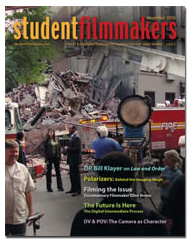Check out this
article in the print edition of StudentFilmmakers
Magazine, November 2006. More behind-the-scenes photos
in the print version. Click
here to get a copy and to subscribe >>
 Ben
Wu Discusses Shooting Docs On DV Ben
Wu Discusses Shooting Docs On DV
Cross Your Eyes Keep Them Wide
...Continued
from Previous Page
What is the purpose of the film, and what were some of
your goals?
Ben Wu: This film aims to understand more of
the problems and prejudices developmentally disabled adults face
in society, and discover how making art at the center has provided
them an incredible community of their own, while also giving them
an invaluable means of expression they would never have otherwise.
For many of the artists, verbal communication can be a struggle.
But through their experience at the studio, art has become their
language. It�s given them a voice that can speak out to a world
that more often than not ignores and fears them. I wanted to tell
some of their stories, and capture the energy, creativity, and
passion found in their work. By doing so I want to try and work
through the negative perceptions so many, me at one time included,
have about the developmentally disabled. At the same time, I definitely
wanted to promote art based programs, like the program at the
center, in creating a nurturing and stimulating place for the
developmentally disabled to grow, both as artists and as people.
Was Cross Your Eyes shot on digital video?
Ben Wu: This film was shot in MiniDV with the
school�s Sony DSR 500, which is a great camera. I was toying with
the idea of buying a Panasonic DVX 100, because I really like
the cinematic look of 24p, but I decided that purchase would have
to wait. And I also was excited to shoot with the 500 because
it�s native 16:9, and I hadn�t really shot with a native 16:9
camera, but always loved the wider aspect ratio. I think that
aesthetic goes a long way, just in that it seems more filmic,
less like TV.
It ended up looking great, but I�m also looking forward to shooting
my next project in 24p. We�ll see how it goes, I love the look,
but am a bit nervous of the low light capabilities of the DVX.
One of the best things about the Sony cameras I�ve used, like
the 500 and especially my old warhorse PD 150, I could shoot anywhere
and still get a decent image lightwise. The little amount of run
and gun stuff I�ve shot with the DVX seems like it needs a lot
more light.
What cameras did you use and how many?
Ben Wu: I shot with the Sony DSR 500 and 570,
which are essentially the same camera. I also shot a little bit
with my PD150, but found it didn�t match so well because of the
16:9 issues (the 500/570 having a native 16:9 chip, and the PD150
doing the fake 16:9 thing).
How did shooting on DV help to tell your story? Could
you talk about the look you wanted to create, and any advantages
shooting on DV?
Ben Wu: I think Cross Your Eyes is sort of a
hybrid verite film, in that there aren�t any talking heads, and
the interviews happen relatively organically, in the flow of the
artists� daily routines. There are a lot of observational shooting,
and DV for me was the only way to accomplish that. To capture
the ebb and flow of the studio, and having to keep the camera
rolling � film, though beautiful, would have been prohibitively
expensive for me to do that.
I felt like I really had to keep the camera rolling in order to
capture those magical moments within the studio; there was no
way to know when something amazing was going to happen. � Also,
there�s that immediacy to video. If we shot something we thought
was interesting, we could look at it that night, or even right
then and there, and figure out a new angle to follow up on, or
a new direction to go. But with film, sending it to the lab, getting
the rushes back, then projecting them, I don�t know, I feel like
some of the momentum is lost. It�s nice to rewind and think, ok,
cool, we got something great, let�s dig deeper into this. For
the look, I wanted it to have nice color balance, which was tough
because of the mixed lighting in the studio. There were huge skylights
letting in a ton of daylight, and big overhead fluorescent lights
as well. So my crew and I were always really vigilant about checking
and readjusting white balance in the space, as well as using the
field monitor as often as possible to check ourselves.
Did any challenges come up, and how did you overcome any
difficulties?
Ben Wu: There were pockets of the studio that
were much dimmer than others, but because of the great low light
capability of the 500, we were still able to get a good exposure.
But one thing I make it a point to stay away from is bumping up
the gain. Unless there is absolutely no other way to bring up
the exposure, I don�t touch it. I just find it really compromises
the quality of the shot; all that video noise just looks really
bad to me. I�d rather try and lower the shutter speed if possible.
But then you have to be careful with motion blur. Luckily lighting
was never really an issue on this film.
Continued
on Next Page...
|
